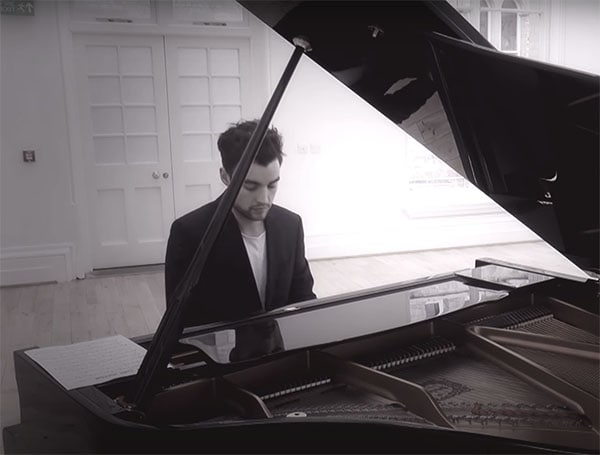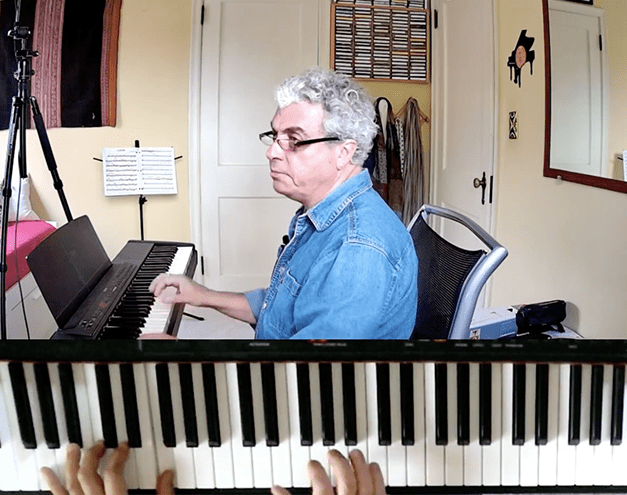
Jovino Santos Neto
Three-time Latin Grammy nominee Jovino Santos Neto, a master pianist, composer and arranger, is among the top Brazilian musicians working today.
Live Seminar Resources
Live Seminar Resources
PDF Downloads
- Seminar Handout
Join PianoGroove Pro to access all downloads and learning resources.
Download theory supplements, midi files, chord changes and full note-for-note transcriptions of every lesson.
- Nearness Of You - Chord Chart
Join PianoGroove Pro to access all downloads and learning resources.
Download theory supplements, midi files, chord changes and full note-for-note transcriptions of every lesson.
- Autumn In New York - Chord Chart
Join PianoGroove Pro to access all downloads and learning resources.
Download theory supplements, midi files, chord changes and full note-for-note transcriptions of every lesson.
- De Mansinho - Chord Chart
Join PianoGroove Pro to access all downloads and learning resources.
Download theory supplements, midi files, chord changes and full note-for-note transcriptions of every lesson.
- Voce e Eu - Chord Chart
Join PianoGroove Pro to access all downloads and learning resources.
Download theory supplements, midi files, chord changes and full note-for-note transcriptions of every lesson.
Seminar Description
Seminar Description
Mastering Melodic Phrasing on Piano
Welcome to this in-depth lesson on melodic phrasing, where we explore how to shape, interpret, and play melodies with greater expression and nuance. Many pianists train extensively in scales, arpeggios, and technical exercises, but developing a lyrical, vocal-like approach to melody can be a game-changer for musicality.
In this lesson, we examine how to contrast intervals, phrase melodies with breath-like articulation, and interpret songs in a way that makes them feel organic and expressive. Using jazz standards like "Autumn in New York" and "The Nearness of You," as well as a Brazilian composition, we focus on how melodic phrasing creates a more natural and engaging sound.
The Importance of Breath in Melodic Playing
One of the biggest breakthroughs in melodic playing comes from understanding the role of breath. Unlike wind or string instruments, the piano does not naturally require breath to produce sound. However, pianists can greatly benefit from imagining the phrasing as if they were singing or playing a wind instrument.
When playing the flute, for example, a musician must decide when to breathe, when to cut a note short, and how to shape the end of a phrase. This concept applies directly to the piano—notes don’t just decay passively; they can be intentionally shaped, cut, or faded to create musical expression.
Contrasting Intervals for Expressive Playing
Great melodies often balance ascending and descending intervals, as well as short and long jumps. For example, consider the classic "Happy Birthday" melody:
- It alternates between stepwise motion and leaps.
- It has a natural rise and fall that makes it easy to remember.
- It contrasts long and short note values, creating dynamic interest.
In jazz, a melody that moves only in a straight, scale-like motion can sound mechanical. Instead, a great improviser weaves in skips, leaps, and rhythmic variations to create a compelling story.
Applying These Concepts to Jazz Standards
"Autumn in New York"
This tune beautifully demonstrates the interplay between melody and harmony. The melody floats above the harmony rather than being rigidly tied to it. Key techniques to observe:
- Breath-like phrasing – Imagine the pauses as natural breaths to shape the line.
- Melodic relief – Avoid overly linear playing by incorporating both small and large intervals.
- Rubato and back-phrasing – Slightly pushing and pulling the melody creates a more expressive interpretation.
"The Nearness of You"
This ballad showcases a slow, lyrical melody with lush harmony underneath. When playing this tune, consider:
- Dynamic control – Vary between soft, whisper-like phrases and full, resonant lines.
- Chromatic movement – Observe how chromatic passing tones add emotional weight.
- Inner voice movement – The harmonies have subtle movements within the chords that add richness to the arrangement.
Exploring Brazilian Melodic Phrasing
We also look at a Brazilian composition, "De Mansinho," which means "gently" in Portuguese. This piece embodies the flowing, lyrical quality of Brazilian music. Key elements include:
- Inversions and voice leading – The bass often moves in stepwise motion, creating fluid harmonic transitions.
- Expressive dynamics – Each phrase has a natural rise and fall, mirroring human speech.
- Subtle rhythmic variations – Brazilian music often employs gentle syncopation that gives the melody a natural swing.
Practice Tips
- Sing the Melody – Even if you are not a singer, vocalizing the melody helps internalize natural phrasing.
- Play the Melody with One Hand – Strip away the harmony and focus purely on shaping the melodic line.
- Experiment with Different Note Lengths – Try playing notes short (staccato), long (legato), and with a gentle fade.
- Analyze Intervallic Motion – Identify where the melody moves stepwise, skips, or leaps, and balance these movements.
- Use Lyrics as a Guide – If the piece has lyrics, use them to shape the phrasing naturally.
By integrating these techniques, you will develop a more expressive and musical approach to playing melodies on the piano. Keep exploring, experimenting, and most importantly—listen deeply to great melodic players for inspiration!







After the seminar I approached Autumn in New York in the way Jovino described. Harmony first. It felt very liberating because I could start thinking about how I would like to create interesting harmonies, not just play the tune and helped me to apply the new techniques I’m learning but a few questions arose
Why do I practice two five ones? The drill never seems to fit the tune. But as I learn to play different tunes I come up with my own convenient ways of playing two five ones that seem to come in handy.
I want to try to apply block chords to the ascending and descending melodies but it seems I still am missing something. If I think of block chord in the first bar, I simply play inversions of the gm7. I’m not finding a place where I would use the cm7flat 5.
I am so accustomed to having most of the cords in my left hand. As long as I keep my hands close together, working with some inversions, this seems adequate. Is there a reason that I should change? I noticed in some of the Tuomos arrangements that most of the time left and right hand are close together and in the cases where they are not it’s a simple case of moving down to a lower or higher register with one of the hands. I know there is the old saying that you should learn some things so that then you can forget it, but at my age I don’t have that much time. :-)
I’m not a good enough player to figure these things out on the fly. So I wind up getting into a song and then getting “paralysis by analysis”. On the other hand, if I play the song the same way long enough to have it memorized, it gets boring. Any suggestions?
HI Sherry,
I’m glad the session was useful for you. That’s exactly what these seminars are designed for – to introduce us to new ideas and concepts.
We practice and isolate 251s because it is the most common progression in jazz music.
I recommend to complete these “whole step” exercises on a daily basis: pianogroove.com/jazz-piano-lessons/whole-step-251-exercises/ – it will help you become more comfortable with harmony and navigating 251s.
In addition, I recommended this course where I walk step-by-step through the harmony of “Nearness Of You”: pianogroove.com/jazz-piano-lessons/ballad-voicings-fills-improv/ – here just using roots 3rds and 7ths to start with. This is an in-depth walkthrough of the harmony concept that Jovino covers in this seminar.
Once you are comfortable you can add the melody on top as we do in the 2nd module of the course.
This is an approach to learning jazz standards from the harmony upwards. Perhaps try it with a jazz standard that you have been playing for years, and see if you can play through the tune just using the chord voicings and no melody. If not that would suggest (1) that you do not know the harmony of the tune, and (2) that you should work 251 progressions so that you can play them quickly for any key.
I think you should forget about block chords for now Sherry and aim to get your playing and chord voicings spread over 2 hands. I demonstrate this step-by-step in my course about “Ballad Voicings Fills” – please see the link above.
Yes you should definitely 100% change this because the harmonic role when voicing chords is most often shared between both hands. Otherwise our playing can sound clunky and one-dimensional.
Yes please see this course: pianogroove.com/jazz-piano-lessons/ballad-voicings-fills-improv/ – it will show you that there are many ways that we can play the same section of music.
Also listen to this playlist everyday: open.spotify.com/playlist/6jw70tZch78Kpx1DeuoUNe?si=c20b7d9bbe4444fe – then try to incorporate things that you like from your favourite recordings in the playlist.
If you are not spending 15 minutes per day on ear training, also start that immediately: pianogroove.com/exercises/
Please watch the lessons in the course and then let me know if you have any questions.
Best,
Hayden
Thanks Hayden,
I have been practicing 251s for quite a while. The work feels useless. My point is that when I learn a tune, the patterns that I learned don’t fit with the melody. I’ve worked with a few tunes and circled the 251 progressions and tried to pull them in but they just don’t fit. Maybe they are more useful when comping, which I don’t do because I have no one to play with. I also don’t see great players like Tuomo and Jovino incorporating these patterns in their style. Maybe It’s there but I’m missing it.
Sherry